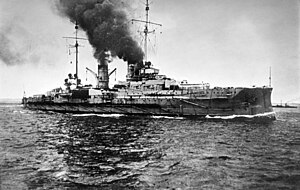SMS Blücher

SMS Blücher in 1912
|
|
| History | |
|---|---|
|
|
|
| Name: | Blücher |
| Namesake: | Gebhard Leberecht von Blücher |
| Builder: | Kaiserliche Werft, Kiel |
| Laid down: | 21 February 1907 |
| Launched: | 11 April 1908 |
| Commissioned: | 1 October 1909 |
| Fate: | Sunk during the Battle of Dogger Bank, 24 January 1915 |
| General characteristics | |
| Class and type: | Armored cruiser |
| Displacement: |
|
| Length: | 161.8 m (530 ft 10 in) overall |
| Beam: | 24.5 m (80 ft 5 in) |
| Draft: | 8.84 m (29.0 ft) |
| Installed power: | 31,562 ihp (23,536 kW) |
| Propulsion: |
|
| Speed: | 25.4 knots (47.0 km/h; 29.2 mph) |
| Range: |
|
| Complement: |
|
| Armament: |
|
| Armor: |
|
SMS Blücher was the last armored cruiser built by the German Empire. She was designed to match what German intelligence incorrectly believed to be the specifications of the British Invincible-class battlecruisers. Blücher was larger than preceding armored cruisers and carried more heavy guns, but was unable to match the size and armament of the battlecruisers which replaced armored cruisers in the British Royal Navy and German Imperial Navy (Kaiserliche Marine). The ship was named after the Prussian Field Marshal Gebhard von Blücher, the commander of Prussian forces at the Battle of Waterloo in 1815.
Blücher was built at the Kaiserliche Werft shipyard in Kiel between 1907 and 1909, and commissioned on 1 October 1909. The ship served in the I Scouting Group for most of her career, including the early portion of World War I. She took part in the operation to bombard Yarmouth and the raid on Scarborough, Hartlepool and Whitby in 1914.
At the Battle of Dogger Bank on 24 January 1915, Blücher was slowed significantly after being hit by gunfire from the British battlecruiser squadron under the command of Vice Admiral David Beatty. Rear Admiral Franz von Hipper, the commander of the German squadron, decided to abandon Blücher to the pursuing enemy ships in order to save his more valuable battlecruisers. Under heavy fire from the British ships, she was sunk, and British destroyers began recovering the survivors. However, the destroyers withdrew when a German zeppelin began bombing them, mistaking the sinking Blücher for a British battlecruiser. The number of casualties is unknown, with figures ranging from 747 to around 1,000. Blücher was the only warship lost during the battle.
...
Wikipedia
